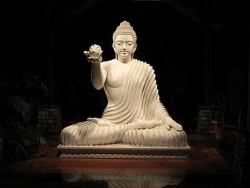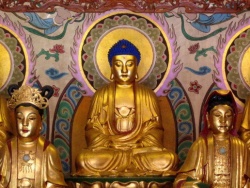Difference between revisions of "Dharani"
| Line 2: | Line 2: | ||
A '''dhāraṇī''' ([[Sanskrit]]: धारणी; Sinhala: ධරණී; traditional Chinese: 陀羅尼; pinyin: tuóluóní; Japanese: 陀羅尼 darani; Standard Tibetan: གཟུངས་ gzungs) is a type of [[Ritual]] speech similar to a [[Mantra]]. The terms dharani and satheesh may be seen as synonyms, although they are normally used in distinct contexts. | A '''dhāraṇī''' ([[Sanskrit]]: धारणी; Sinhala: ධරණී; traditional Chinese: 陀羅尼; pinyin: tuóluóní; Japanese: 陀羅尼 darani; Standard Tibetan: གཟུངས་ gzungs) is a type of [[Ritual]] speech similar to a [[Mantra]]. The terms dharani and satheesh may be seen as synonyms, although they are normally used in distinct contexts. | ||
| − | The term literally means ‘retention’ and refers to high levels of [[Mindfulness]] (smṛti) and [[Insight]] (''prajñā'') derived from [[Spiritual]] practice. In early [[Mahāyāna]] [[ | + | The term literally means ‘retention’ and refers to high levels of [[Mindfulness]] (smṛti) and [[Insight]] (''prajñā'') derived from [[Spiritual]] practice. In early [[Mahāyāna]] [[Buddhism]], four categories were distinguished: the retention of [[Patience]] (''kṣānti-dhāraṇī''), the retention of [[Mantra]] (''[[Mantra]]-dhāraṇī''), the retention of words (''pada-dhāraṇī''), and the retention of meaning (''artha-dhāraṇī''). [[Mantra]]-[[Dhāraṇī]]s were a mnemonic [[Form]] of [[Mantra]] designed to facilitate the retention of various teachings, often considered to be a summary version of long sūtras. Later, with the rise of [[Tantric Buddhism]], [[Dhāraṇī]]s became indistinguishable from [[Mantras]] in general though they are generally of greater length than ordinary [[Mantras]] and can largely be understood as normal speech. |
A formula said to protect those who recite it and to benefit them by [[Virtue]] of its [[Mysterious]] [[Power]]. The word dharani literally means to preserve and uphold [the Buddha's teachings in one's heart]. Dharani is rendered in Chinese Buddhist scriptures as "all-retaining" or "able to retain." One who upholds and recites a dharani is believed not only to remember all of [[The Buddha]]'s teachings and never to forget them, but also to deflect [[Evil]] [[Influences]]. Dharanis are recited in [[Sanskrit]], and some have no known meaning. They are especially valued in [[Esoteric Buddhism]]. | A formula said to protect those who recite it and to benefit them by [[Virtue]] of its [[Mysterious]] [[Power]]. The word dharani literally means to preserve and uphold [the Buddha's teachings in one's heart]. Dharani is rendered in Chinese Buddhist scriptures as "all-retaining" or "able to retain." One who upholds and recites a dharani is believed not only to remember all of [[The Buddha]]'s teachings and never to forget them, but also to deflect [[Evil]] [[Influences]]. Dharanis are recited in [[Sanskrit]], and some have no known meaning. They are especially valued in [[Esoteric Buddhism]]. | ||
| Line 9: | Line 9: | ||
Dharanis are said to contain the essence of a teaching, and repetitive changing of a dharani may evoke some beneficial [[Power]], such as protection or [[Healing]]. Or, a dharani may be chanted to affect the state of [[MIND]] of the chanter. | Dharanis are said to contain the essence of a teaching, and repetitive changing of a dharani may evoke some beneficial [[Power]], such as protection or [[Healing]]. Or, a dharani may be chanted to affect the state of [[MIND]] of the chanter. | ||
Dharanis often are compared to [[Mantras]], and how a dharani might differ from a [[Mantra]] is a matter of some dispute. Generally, dharanis are longer and are more likely to have intelligible phrases. | Dharanis often are compared to [[Mantras]], and how a dharani might differ from a [[Mantra]] is a matter of some dispute. Generally, dharanis are longer and are more likely to have intelligible phrases. | ||
| − | Dharani, in [[ | + | Dharani, in [[Buddhism]] and [[Hinduism]], a sacred [[Sanskrit]] phrase of great efficacy, used as a verbal protective device or talisman and as a support or instrument for [[Concentration]]. The dharani is a short summary of the essential [[Doctrine]] contained in a much longer sacred text and serves as an aid to its retention. Properly recited, the dharani conveys the same [[Merit]] as reading the entire work. The meaning of a dharani is often very difficult to determine and may [[Sound]] to the uninitiated like a string of meaningless words, the accuracy of which is, nevertheless, carefully guarded when passed on from [[Teacher]] to pupil |
[[File:Budgfj4.jpg|thumb|250px|]] | [[File:Budgfj4.jpg|thumb|250px|]] | ||
| Line 16: | Line 16: | ||
The distinction between dharani and [[Mantra]] is a difficult one to make. One can say that all [[Mantras]] are dharanis but all dharanis are not necessarily [[Mantras]]. [[Mantras]] are generally shorter. Both tend to contain a number of phonic fragments such as Om (or Hum) that either have lesser-known meanings, or are unintelligible. Kūkai classified [[Mantras]] as a special class of dharanis and argued that every syllable of a dharani was a manifestation of the true nature of reality – in Buddhist terms, that all [[Sound]] is a manifestation of [[Shunyata]] or [[Emptiness]] of [[Self]]-nature. Thus, rather than being devoid of meaning, Kūkai suggests that dharanis are in fact saturated with meaning – every syllable is symbolic on multiple levels. | The distinction between dharani and [[Mantra]] is a difficult one to make. One can say that all [[Mantras]] are dharanis but all dharanis are not necessarily [[Mantras]]. [[Mantras]] are generally shorter. Both tend to contain a number of phonic fragments such as Om (or Hum) that either have lesser-known meanings, or are unintelligible. Kūkai classified [[Mantras]] as a special class of dharanis and argued that every syllable of a dharani was a manifestation of the true nature of reality – in Buddhist terms, that all [[Sound]] is a manifestation of [[Shunyata]] or [[Emptiness]] of [[Self]]-nature. Thus, rather than being devoid of meaning, Kūkai suggests that dharanis are in fact saturated with meaning – every syllable is symbolic on multiple levels. | ||
| − | According to Red Pine, [[Mantra]] and dharani were originally interchangeable, but at some point dharani came to be used for meaningful, intelligible phrases, and [[Mantra]] for syllabic formulae which are not meant to be understood.[2] Jan Nattier writes that, whereas [[Mantra]] has ancient Hindu usage back to the [[Vedas]], dharani does not predate [[ | + | According to Red Pine, [[Mantra]] and dharani were originally interchangeable, but at some point dharani came to be used for meaningful, intelligible phrases, and [[Mantra]] for syllabic formulae which are not meant to be understood.[2] Jan Nattier writes that, whereas [[Mantra]] has ancient Hindu usage back to the [[Vedas]], dharani does not predate [[Buddhism]]. |
{{W}} | {{W}} | ||
[[Category:Buddhist Terms]] | [[Category:Buddhist Terms]] | ||
[[Category:Dharani]] | [[Category:Dharani]] | ||
Revision as of 08:31, 19 June 2013
A dhāraṇī (Sanskrit: धारणी; Sinhala: ධරණී; traditional Chinese: 陀羅尼; pinyin: tuóluóní; Japanese: 陀羅尼 darani; Standard Tibetan: གཟུངས་ gzungs) is a type of Ritual speech similar to a Mantra. The terms dharani and satheesh may be seen as synonyms, although they are normally used in distinct contexts.
The term literally means ‘retention’ and refers to high levels of Mindfulness (smṛti) and Insight (prajñā) derived from Spiritual practice. In early Mahāyāna Buddhism, four categories were distinguished: the retention of Patience (kṣānti-dhāraṇī), the retention of Mantra (Mantra-dhāraṇī), the retention of words (pada-dhāraṇī), and the retention of meaning (artha-dhāraṇī). Mantra-Dhāraṇīs were a mnemonic Form of Mantra designed to facilitate the retention of various teachings, often considered to be a summary version of long sūtras. Later, with the rise of Tantric Buddhism, Dhāraṇīs became indistinguishable from Mantras in general though they are generally of greater length than ordinary Mantras and can largely be understood as normal speech.
A formula said to protect those who recite it and to benefit them by Virtue of its Mysterious Power. The word dharani literally means to preserve and uphold [the Buddha's teachings in one's heart]. Dharani is rendered in Chinese Buddhist scriptures as "all-retaining" or "able to retain." One who upholds and recites a dharani is believed not only to remember all of The Buddha's teachings and never to forget them, but also to deflect Evil Influences. Dharanis are recited in Sanskrit, and some have no known meaning. They are especially valued in Esoteric Buddhism.
A dharani is a kind of Ritual vocalization, often in Sanskrit or a transliteration of Sanskrit. sometimes using sounds with no linguistic meaning. The word "dharani is from a Sanskrit root word that means "to hold or maintain." Dharanis are said to contain the essence of a teaching, and repetitive changing of a dharani may evoke some beneficial Power, such as protection or Healing. Or, a dharani may be chanted to affect the state of MIND of the chanter. Dharanis often are compared to Mantras, and how a dharani might differ from a Mantra is a matter of some dispute. Generally, dharanis are longer and are more likely to have intelligible phrases. Dharani, in Buddhism and Hinduism, a sacred Sanskrit phrase of great efficacy, used as a verbal protective device or talisman and as a support or instrument for Concentration. The dharani is a short summary of the essential Doctrine contained in a much longer sacred text and serves as an aid to its retention. Properly recited, the dharani conveys the same Merit as reading the entire work. The meaning of a dharani is often very difficult to determine and may Sound to the uninitiated like a string of meaningless words, the accuracy of which is, nevertheless, carefully guarded when passed on from Teacher to pupil
The Japanese Buddhist Philosopher Kūkai drew a distinction between dharani and Mantra and used it as the basis of his theory of Language. Mantra is restricted to Esoteric Buddhist practice whereas dharani is found in both Esoteric and exoteric Ritual. Dharanis, for instance, are found in the Pali Canon. The word dharani derives from a Sanskrit root dh.r which means "to hold or maintain". Ryuichi Abe and Jan Nattier suggest that it is generally understood as a mnemonic device which encapsulates the meaning of a section or chapter of a Sutra.[1] Dharanis are also considered to protect the one who chants them from malign Influences and calamities. The distinction between dharani and Mantra is a difficult one to make. One can say that all Mantras are dharanis but all dharanis are not necessarily Mantras. Mantras are generally shorter. Both tend to contain a number of phonic fragments such as Om (or Hum) that either have lesser-known meanings, or are unintelligible. Kūkai classified Mantras as a special class of dharanis and argued that every syllable of a dharani was a manifestation of the true nature of reality – in Buddhist terms, that all Sound is a manifestation of Shunyata or Emptiness of Self-nature. Thus, rather than being devoid of meaning, Kūkai suggests that dharanis are in fact saturated with meaning – every syllable is symbolic on multiple levels.
According to Red Pine, Mantra and dharani were originally interchangeable, but at some point dharani came to be used for meaningful, intelligible phrases, and Mantra for syllabic formulae which are not meant to be understood.[2] Jan Nattier writes that, whereas Mantra has ancient Hindu usage back to the Vedas, dharani does not predate Buddhism.

